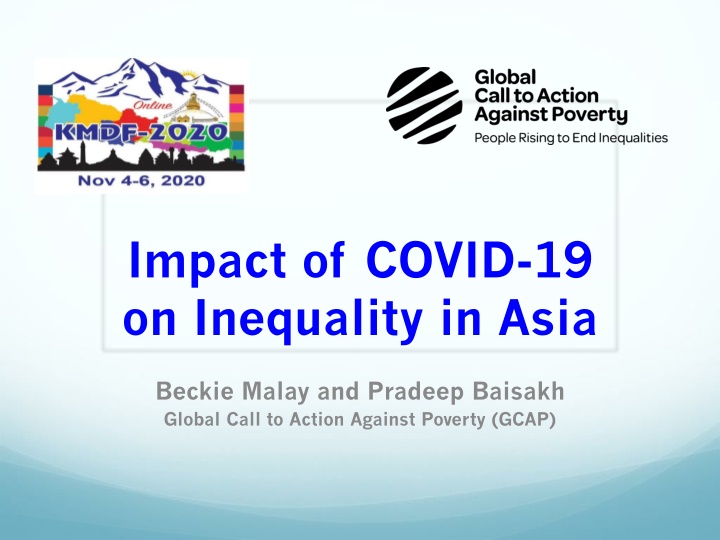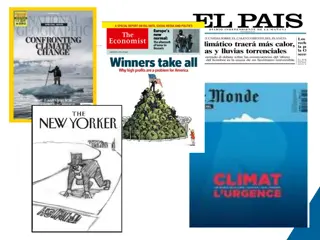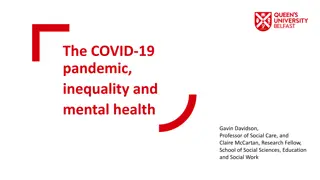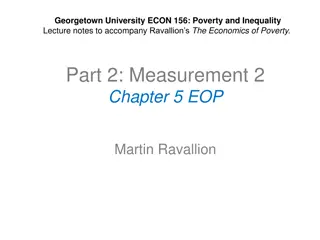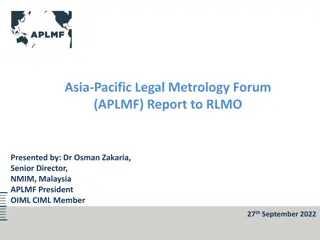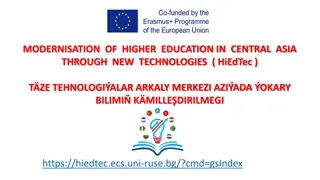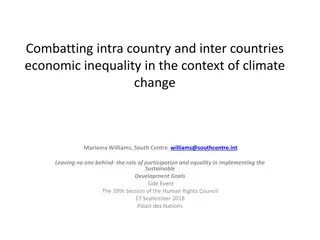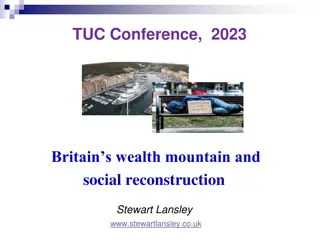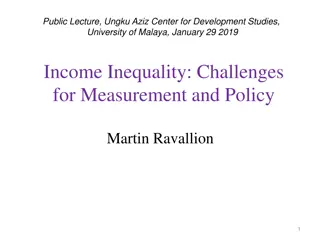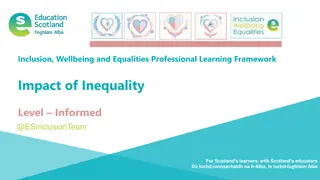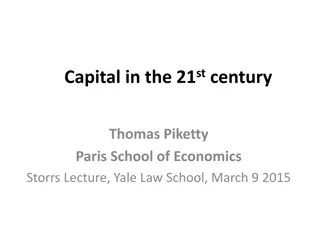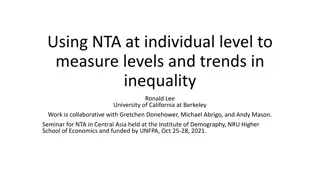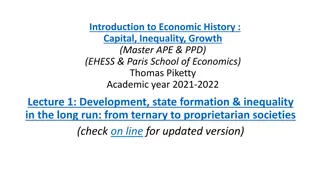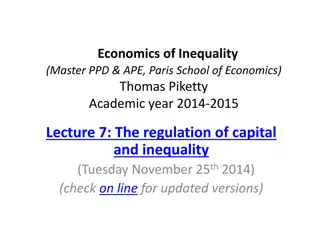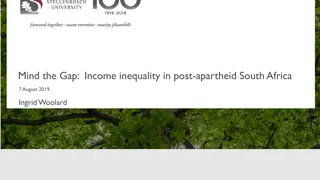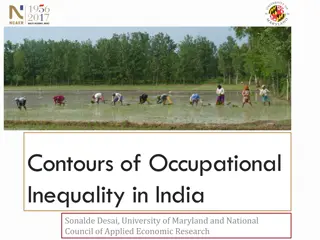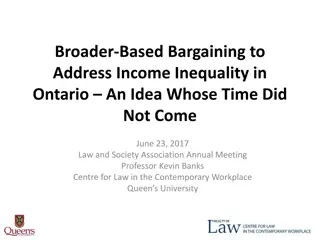Impact of COVID-19 on Inequality in Asia
In spite of poverty reduction efforts, rising inequality in Asia remains a critical concern that has been exacerbated by the COVID-19 pandemic. This article explores the impact of COVID-19 on vulnerable groups and income inequality, highlighting the pre-existing disparities and challenges faced by marginalized communities in the region.
Uploaded on Mar 04, 2025 | 0 Views
Download Presentation

Please find below an Image/Link to download the presentation.
The content on the website is provided AS IS for your information and personal use only. It may not be sold, licensed, or shared on other websites without obtaining consent from the author.If you encounter any issues during the download, it is possible that the publisher has removed the file from their server.
You are allowed to download the files provided on this website for personal or commercial use, subject to the condition that they are used lawfully. All files are the property of their respective owners.
The content on the website is provided AS IS for your information and personal use only. It may not be sold, licensed, or shared on other websites without obtaining consent from the author.
E N D
Presentation Transcript
Impact of COVID-19 on Inequality in Asia Beckie Malay and Pradeep Baisakh Global Call to Action Against Poverty (GCAP)
Introduction In spite of poverty reduction efforts since the late 1990 s, where 80 per cent of extreme poor in Asia Pacific were lifted of poverty by 2015, rising inequality remains a great cause of concern COVID revealed the pre-existing inequalities and exacerbated inequalities for the poor and the marginalised Definitions: Inequality is the difference in social status, wealth, or opportunity between people or groups Inequality of Outcome refers to economic inequality in income and wealth Inequality in Opportunities refers to unequal access to essential services Inequality of Impacts refers to differentiated and asymmetric impacts from environmental hazards
Changes in income inequality by subregions, 1990 and 2014
Some data on Income Inequality In 2019, the world s billionaires numbering 2,153 people, have more wealth than 4.6 billion people The monetary value of women s unpaid care work globally for women aged 15 and over is three times the size of the world s tech industry Taxing an additional 0.5% of the wealth of the richest 1% over the next 10 years can create 117 million additional jobs According to the Billionaires Insights Report 2020 (October 2020), Asia and Pacific has highest number of super rich. (40% of the world) It has 831 billionaires with wealth totals US$3.23 trillion The irony is Asia Pacific region has exceeded the Americas (762 or 35%) and the Europeans, Middle Eastern and African billionaires (596 or 27%).
Impact of COVID-19 on vulnerable groups (SDGs and human rights) General Facts: Though 80 per cent of extreme poor in Asia Pacific were lifted of poverty by 2015, rising inequality remains a great cause of concern High level of informalisation of labour is a worrying trend 60% are not covered by any social protection and 40% have no access to healthcare COVID Impact: It s now projected that GDP growth slumped or will be negative for 2020 for many countries This is likely to affect the poor and informal sector more than others
Growth projections ESCAP (Mar 20) IMF , Oct 3
Impact Groups affected (Faces of Inequality): Geographically inaccessible areas, orphan, LGBTQI ,old, women, children, Indigenous communities, Dalits (DWD community), sex worker, beggar, homeless, small and marginal farmers, daily wage worker in the urban areas In South Asia 132 million people will be pushed into extreme poverty and inequalities will be accentuated Demand for the unpaid work increased bearing more burdens on women and the time has witnessed rise in gender-based violence Countries like Nepal whose economy are remittance dependent, are more affected that others inequality between countries during COVID SDG were out of track in SE Asia and will now further slip Hunger reported in South Asia, and in SE Asia food was available but issue of access for the marginal groups as malls open but not street food Non-residents have been unfairly blamed for spreading the virus. They have faced violence and discriminatory practices across the region Afghanistan - health system affected by conflicts; in India millions of migrants walked the streets hungry and many died en route; Japan issue of privacy of the sex workers and in Singapore poor living condition for 300,000 migrant workers
Income Inequality during COVID Globally about 500 million more people could be pushed into poverty as a result of the pandemic GAFA firms (Tech companies like Alphabet, Facebook and Amazon) and Microsoft are expected to make 46 billion USD more profit in 2020 than before the pandemic. Most of the profit is paid to their shareholders while taxes are avoided The causes of inequality among the rich and poor countries are also rooted in the extortive financial system in the world US$300 billion is being spent annually by the Global South for Public External Debt payments to bilateral and multilateral lenders such as the World Bank and IMF , private banks, speculators etc. And many countries cannot spend on food and relief during pandemic. Many African, Latin American and some Middle Eastern countries commonly pay more than 10% interest on their borrowings while richer nations can pay 1% or less
Impact of COVID on democracy and civic space Across the region/globe governments have invoked emergency clauses during the pandemic to curtail freedom of association and limit other human rights It curtailed the media freedom, freedom of expression and civic space to the extent, which fail the test of international standards Vaguely worded provisions have potential to violate various freedoms and human rights Cases of gaging media and arresting journalists in Philippines and India Positive news about elections in Sri Lanka (August 5) and South Korea (April) high participation and broadly free and fair
Governments Response Lockdowns and shutdowns to prevent spread of COVID Testing, tracing and treating COVID - free in some, expensive in most countries Public intervention to increase hospital capacity on medical supplies Subsidies for testing and treatment of the disease Support to the poor by supplying food and ration Cash dole out (Singapore), Ehsaas scheme (Pakistan) etc and economic package for long term recovery in most countries Tax-exemptions and subsidies to revive MSMEs Hong Kong, China and Singapore have subsidised some sectors like retail, food, transport and tourism, which involves the livelihood of low- income families Regional Cooperation - SAARC COVID-19 emergency fund ($21 million till April) ASEAN level communications - organized multiple meetings and conferences in the areas of health, economic and security areas
Economic Package (% of GDP) (As on 28/08/2020) Mongolia Japan Singapore Philippines Indonesia Cambodia Thailand Bangladesh Nepal Sri Lanka India Pakistan Kazakhstan 0 5 10 15 20 25 30 35 40 45
Assessment of the governments response Hunger, discrimination and exclusion were widely reported in some countries, mainly in South Asia Dalits in India, Nepal and other South Asian countries continued to face discrimination Due to curtailment of media freedom and civic space - prevailing sense that many governments under-reported the COVID cases across the regions Farmers faced huge problem in selling their produce due to restrictions in movement - Nepal, the farmers threw milk, tomatoes In Myanmar the conflict between military and ethnic armed groups continued till UNSG called for ceasefire Illicit trafficking, organized crime, drug production in the South East Asia appear not to have been much affected Use of technology to track the disease issue of privacy involved
CSOs Response global and regional Globally 400 CSOs working on human rights and SDG issued a 12-point demand charter Just recovery - universal healthcare, reducing inequalities and guaranteeing human rights Re-think our economies in response to the parallel crises of climate change and biodiversity Global Solidarity Action on 22 May (by GCAP , Action4SD and others) with hashtag #StrongerTogether. 6,000 posts, reached 43 million people & 126 million impressions in more than 100 countries Asia level: Regular webinars among the interested civil society organsiations to update each other on the developments in each countries and do a cross comparision
CSOs response national Food to the hungry - relief programmes consisting of distribution of food packs and mobile kitchens were set up by the CSOs Mobilising support to jobless people in informal sector Monitoring the government relief and cash supports Issuing statements - many GCAP National Coalitions and others did Afghanistan SDO and many other NGOs are directly involved in tracing testing and treating the covid patients Pakistan Awaz foundation helping the most marginalised to get benefits of Ehsaas Cash Grants Nepal - NGO Federation coordinated and brought together NHRC, Nepal Bar Association, Federation of Nepalese Journalists to form the Human Rights Monitoring Netowork to monitor the human rights situation of during the COVID-19 pandemic Philippines use of social media to highlight cause of poor and vulnerable and link to relief Dalit groups in India App to track migrants and help them CSOs in general also intensified the use of digital platforms in lieu of face-to-face conferences and meetings UN bodies release regional reports and did webinars CSOs did rise to the occasion despite shrinking space
Recommendations to the governments Provide comprehensive social protection to the most vulnerable groups cash transfers, health insurance, etc. Prioritise investments in education to increase chances for social mobility Address the digital divide and provide access to technology also related to data collection Protect people from environmental hazards climate-proof agriculture and food systems, DRRM Ensure a HRBA to sustainable development
Recommendations for the UN and CSOs For the UN systems: Provide guidance to states on interlinking the processes of Human Rights (UPR) and Sustainable Development (HLPF) Enhance multilateral efforts for financing sustainable development thru the unconditional cancellation of the debts of poor countries; set up mechanisms to address illicit financial flows that will effectively penalise tax havens, etc. For CSOs: Strengthen solidarity through closer cooperation at all levels
Recommendations for the CSOs Engage national and local governments through partnerships, whether through direct service delivery or policy advocacy Establish accountability and integrity mechanisms and report back to people to enhance participation Amplify the voices of communities through all means available to provide access for the marginalised
References Theme Study on Inequality, ESCAP 2018 https://www.unescap.org/publications/inequality- asia-and-pacific-era-2030-agenda-sustainable- development Fighting Inequality in the Time of COVID 19, Oct. 2020 https://oxfamilibrary.openrepository.com/handle/1 0546/621061
Thank You! beckiemalay@yahoo.com pradeep.baisakh@gcap.global
